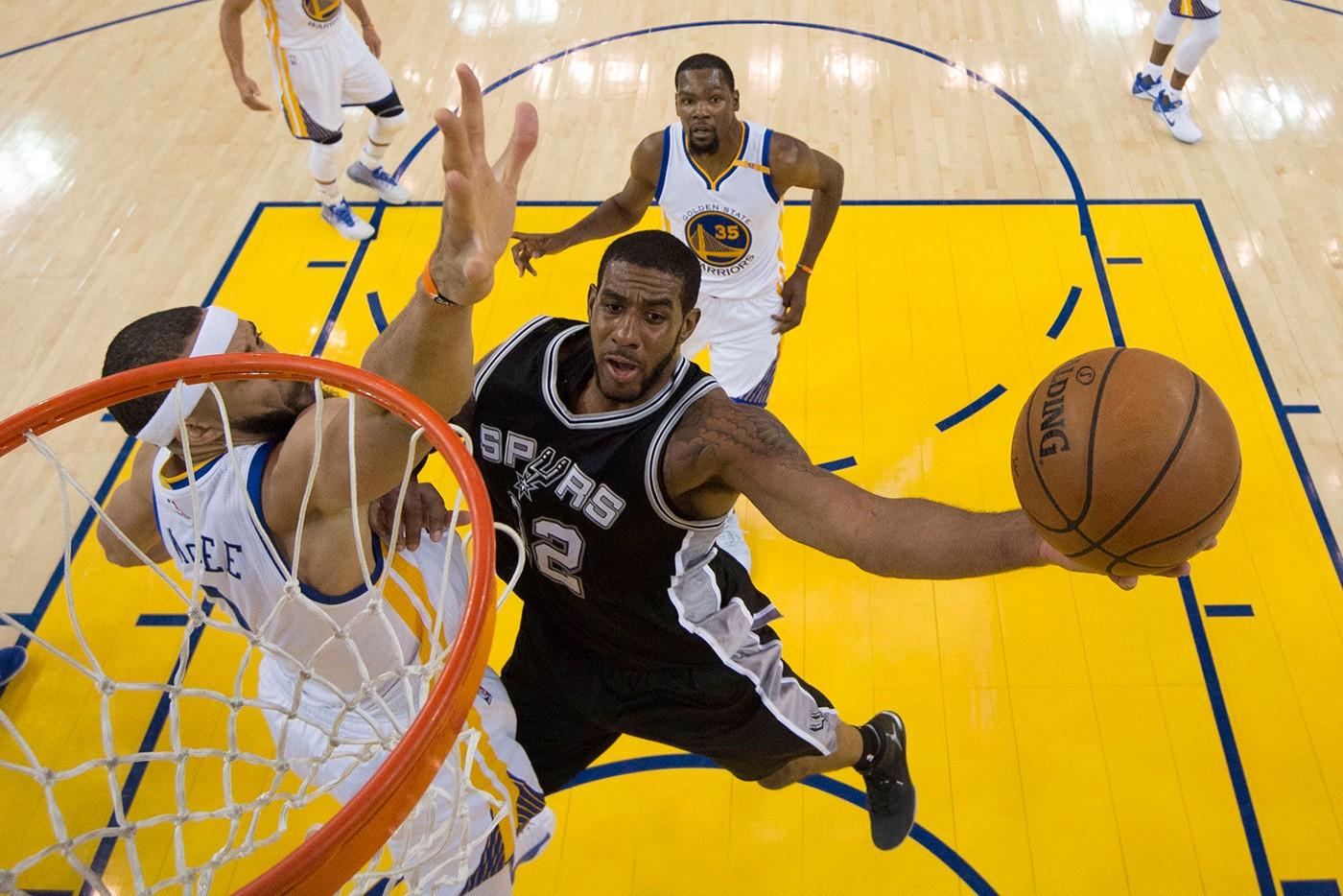
We might have been robbed of a classic playoff series on Sunday. The Spurs were up 78–55 on the Warriors in Game 1 of the Western Conference finals when Zaza Pachulia stepped under Kawhi Leonard’s foot, reaggravating the ankle injury that knocked him out of San Antonio’s second-round series against the Rockets. San Antonio embarrassed Houston without its star last week, but trying to beat Golden State while shorthanded is a completely different challenge. The Warriors demolished the Spurs in the final 20 minutes to pull out a 113–111 win. With Kawhi’s status uncertain, and Tony Parker out for the playoffs, Gregg Popovich doesn’t have many options left to go to on offense.
Before Kawhi’s injury, Pop had done almost everything right, putting his team in position to pull off the massive upset with a game plan that exposed the weak spots in the Warriors rotation. Interim coach Mike Brown made some bizarre rotation decisions, most notably going to the Lineup of Death, with Draymond Green at the 5, for only one 12-second stretch in the first half. Golden State played with one hand tied behind its back until the fourth quarter, when the Warriors finally went with a smaller lineup that gave Kevin Durant and Steph Curry the space to go nova.
Kawhi wasn’t the only big injury on Sunday, as Andre Iguodala was held out for the entire second half with knee soreness. It’s hard to know what to expect in Tuesday’s Game 2 until we know more about their statuses, although the short turnaround makes a return for either doubtful, especially since keeping them out would give them six days of rest until Game 3 on Saturday. The Spurs may have missed their best chance to steal a game in Oracle when they couldn’t close out Game 1, and they will have to make some adjustments to keep things competitive if Kawhi can’t play. With so much in the air for both teams, here’s a look at five story lines to watch in this series going forward:
Can the Spurs Keep Pau Gasol on the Floor?
San Antonio was one of the biggest teams in the NBA in the regular season, but the Spurs have gone smaller in the playoffs, using a three-big-man rotation (LaMarcus Aldridge, Pau Gasol, and David Lee) and playing large stretches of the game with only one on the floor. Neither Aldridge nor Lee is a great perimeter defender, but they are much more capable of extending out to the 3-point line on defense than Gasol, who flat-out refused to leave the paint in Game 1.
The Warriors came out determined to attack Gasol in the second half, with Curry scoring 11 points in three minutes, all of them in plays where Gasol’s man (Zaza Pachulia) screened for him. Gasol’s ability to block shots was huge in the Spurs’ series against the Rockets, but the Warriors are more equipped to punish him when he hangs out at the rim. Not only is Curry a better pull-up shooter than James Harden, but Golden State’s wealth of perimeter options means the Spurs have to leave Patty Mills on Curry, and Mills isn’t big enough to fight over screens. Mills needs help from his big men to prevent Curry from getting open looks. Pop called a timeout to yell at Pau after this play in the third quarter:
After averaging 25 minutes a game against Houston, Gasol played only 16 minutes in Game 1, even with Kawhi’s injury forcing Pop to go deeper into his rotation. Jonathon Simmons will take Kawhi’s spot in the starting lineup if the Spurs star can’t play in Game 2, but that might not be the only adjustment the Spurs make. They might be better off playing Gasol against the Warriors reserves at the midway point of each half, when neither Durant nor Curry is in the game. Either way, if Gasol can’t play better than he did on Sunday, when he had as many personal fouls (five) as points, he might not play much at all.
How Much Small Ball Will the Warriors Play?
Golden State lost control of the game when Brown started making substitutions. When he took Pachulia and Green out with 5:18 left in the first quarter, the Warriors were down 14–11. The Spurs went on a 32–10 run over the next 10 minutes, as Brown stuck with ineffective lineups that had little chance of working. He played Iguodala, Green, Shaun Livingston, and JaVale McGee together at the end of the first quarter, and there wasn’t enough shooting on the floor for the Warriors to score. At the start of the second, he ran the offense through David West, a strategy which makes sense when trying to buy time in the regular season, not in the crucible of the Western Conference finals. At this stage of the postseason, the game changes quickly when a coach is asleep at the wheel.
One of Steve Kerr’s strengths as a coach is his ability to manage the rotation, and he’s not afraid to go for the kill in the playoffs. The Warriors were plus-11 in Draymond’s 12 minutes at center in the second half; their substitution pattern should maximize the amount of time they play their best lineups. The easiest fix is to give Draymond more of a rest when the second unit is in, swapping out the minutes when he’s playing power forward with the reserves for minutes when he’s playing center with the starters.
Going small will be harder with Iguodala out, but the Warriors would be better off giving more minutes to Livingston, Matt Barnes, and Ian Clark than staying bigger. Livingston took Iguodala’s spot in the Lineup of Death in the fourth quarter, and he essentially played like a big man, rolling to the rim, crashing the offensive boards, and scoring out of the post. Even when Kawhi is on the floor, the Warriors have a huge offensive advantage when they play five-out against the Spurs. When Kawhi is out, Golden State can almost score at will when it goes small. Look at the spacing in this play in the last two minutes that creates an open 3 for Klay Thompson:
Will the Warriors’ Role Players Make 3s?
If there’s a hole in the Golden State roster, it’s the lack of 3-point shooting in its supporting cast. While Durant, Thompson, and Curry are three of the best shooters in NBA history, the Golden State roster doesn’t have many other long-range threats. The Warriors’ top three scorers attempted 27 of the team’s 30 3s on Sunday. The Spurs’ game plan in this series is to force someone else to beat them from the perimeter. In this sequence, Curry’s drive to the rim attracts four different defenders, and he is forced to kick it out, eventually resulting in a turnover:
Brown, a former Popovich assistant, played right into his mentor’s hands with some of his lineup choices, but no matter how he sets up his rotation, he will have to rely on Draymond, Iguodala, and Barnes to knock down open looks. They are all capable shooters: Iguodala and Barnes shot at least 36 percent from 3 in the regular season, and Green is shooting 50 percent from deep in the playoffs. However, trying to beat the Warriors is about playing the percentages, and those are the best percentages a defense is going to get. One good adjustment Brown made in the second half was playing Clark, the best shooter on their bench, and he was plus-5 in five minutes in the fourth quarter. Clark is not a good defensive player, so the Spurs should be attacking him whenever he plays in the hope of goading Brown to take him out of the game.
Can the Spurs Make Life Easier for LaMarcus Aldridge?
Aldridge has been under a microscope this season in San Antonio, particularly after struggling in their first-round series against the Grizzlies and in the first few games of their series with the Rockets. He came alive to close out Houston in Game 6, with 34 points, on 16-of-26 shooting, and 12 rebounds, and they will need him to continue playing at that level to have any chance of beating Golden State. Aldridge had 28 points, on 11-of-24 shooting, eight rebounds, and three assists in Game 1, but he will need to be much more efficient going forward.
The biggest problem for Aldridge is that he’s going up against Draymond Green, the front-runner for the Defensive Player of the Year award. Green, at only 6-foot-7, gives up a lot of size, but he makes up for it with freakishly long arms (7-foot-1 wingspan), a wide base that prevents Aldridge from establishing deep post position, and a maniacal determination to contest shots taken anywhere near him. Aldridge was 2-of-9 with Green as his primary defender in Game 1, and 9-of-15 against anyone else. This is how most of Aldridge’s possessions looked when he was trying to score one-on-one against Green:
Aldridge has a lethal turnaround jumper, but he tends to settle for it too often, especially when going up against a player as physical as Green. The Spurs should be trying to involve Aldridge in pick-and-rolls whenever Draymond is guarding him in order to get a weaker defender on him. Trying to post up Green plays right into the Warriors’ hands. Aldridge turned the ball over six times in Game 1. Using him as a screener is a more effective way to create open shots for his teammates than asking him to pick apart the Warriors’ aggressive double-teams. This is the kind of play the Spurs need more of in Game 2:
Will Kyle Anderson Get a Bigger Role?
Anderson was one of the only bright spots for the Spurs in the second half, as he filled up the stat sheet (four points on 2-of-3 shooting, four rebounds, two assists, and one steal) in only nine minutes. Anderson was a minus-3 in Game 1, even though all his playing time came without Kawhi. In the 11 minutes in the second half without either Kawhi or Anderson in the game, the Spurs were minus-22. Anderson was probably not high on the Warriors’ scouting report coming into the game, and he has some defensive weaknesses they can exploit with more preparation, but San Antonio may have no choice but to roll the dice and put him on the floor to boost their offense.
Anderson is one of the most unusual players in the NBA. At 6-foot-9 and 230 pounds with a 7-foot-3 wingspan, he has the size of a power forward and the skill set of a much smaller player. He was a point guard in his final season at UCLA. Despite his youth, he has the foot speed of a glacier, but he makes up for it with a high basketball IQ, and he almost always puts himself in the right position to make a play. Anderson is as comfortable taking defenders off the dribble at the 3-point line as he is crashing the offensive glass, and he stretches out the Warriors defense while still keeping some size on the floor. None of the Spurs’ other big men could make a play like this when attacking a close-out:
Anderson gives San Antonio another ball handler and playmaker, two things in short supply without Kawhi or Parker. Their best stretch after Kawhi’s injury in Game 1 came when they played Anderson with one big man and three wings, all of whom were are at least 6-foot-5. Having Anderson in allows Pop to take Mills out, which improves their defense because Mills’s lack of size (6-foot and 185 pounds) makes switching screens on the perimeter difficult. The Spurs need one of their reserves to have a breakout performance to keep the series close without their injured stars, and Anderson is the most likely candidate to do that.

